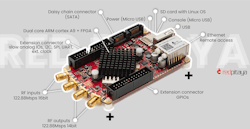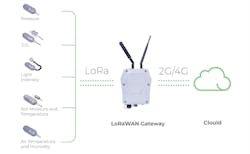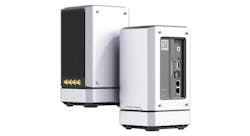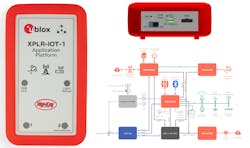Spotlight on IoT Kits and an FPGA Test System
Check out more Sensors Converge coverage.
Digi-Key's Scott Raeker discusses some IoT kits and and an FPGA-based test and measurement system, including ones from Red Pitaya, Seeed Studio, and u-blox.
FPGA Software-Defined Radio Platform
The Red Pitaya SDRlab 122-16 is a software-defined-radio (SDR) system based on Xilinx's Zynq SoC (Fig. 1). The platform has a pair of 50-Ω inputs connected to 16-bit ADCs. Dual 14-bit DACs drive the two 50-Ω outputs.
The system comes with open-source tools and software, and it can be controlled remotely using development tools like LabVIEW, MATLAB, Scilab, as well as Python. There are also oscilloscope, signal-generator, spectrum, and logic-analyzer applications that work with the system. These can be handy for development work as well as providing a programmable test-and-measurement system.
LoRaWAN Development Kits
Seeed Studio LoRaWAN support spans individual modules through kits that include gateways and evaluation boards (Fig. 2). LoRaWAN is a low-speed, long-distance wireless network that's ideal for many IoT applications in areas such as smart agriculture and smart cities.
Seeed Studio's LoRa systems range from modules that can be incorporated into an embedded system as well as fully functional, rugged systems designed for field deployment.
The demo tied the sensors and gateway to applications running on a Seeed Studio reServer (Fig. 3). The platform is available with different processors such as NVIDIA's Jetson AGX Orin and Intel Core i3. It has two 2.5-Gb Ethernet ports as well as optional wireless support for protocols such as 5G, LoRa, Bluetooth, and Wi-Fi.
Exploring IoT
Developers looking to build a fully functioning IoT prototype can start with the u-blox XPLR-IOT-1 (Fig. 4). It includes a dual-core, Arm Cortex-M33 application processor and can be configured to handle a range of sensors and wireless protocols including NFC, GPS, cellular, and short-range radio systems.
The system supports Thingstream MQTT for IoT connectivity. Cellular support features 400-MHz LTE-M and NB-IoT with Secure Cloud.
On-board sensors include accelerometers, magnetometers, gyroscope, ambient-light sensor, and battery gauge. There's a Qwiic connector for expansion. The protective silicone case allows for real-world deployment. Preloaded firmware provides access to sensors and the cloud via Thingstream.
Links
About the Author
William G. Wong
Senior Content Director - Electronic Design and Microwaves & RF
I am Editor of Electronic Design focusing on embedded, software, and systems. As Senior Content Director, I also manage Microwaves & RF and I work with a great team of editors to provide engineers, programmers, developers and technical managers with interesting and useful articles and videos on a regular basis. Check out our free newsletters to see the latest content.
You can send press releases for new products for possible coverage on the website. I am also interested in receiving contributed articles for publishing on our website. Use our template and send to me along with a signed release form.
Check out my blog, AltEmbedded on Electronic Design, as well as his latest articles on this site that are listed below.
You can visit my social media via these links:
- AltEmbedded on Electronic Design
- Bill Wong on Facebook
- @AltEmbedded on Twitter
- Bill Wong on LinkedIn
I earned a Bachelor of Electrical Engineering at the Georgia Institute of Technology and a Masters in Computer Science from Rutgers University. I still do a bit of programming using everything from C and C++ to Rust and Ada/SPARK. I do a bit of PHP programming for Drupal websites. I have posted a few Drupal modules.
I still get a hand on software and electronic hardware. Some of this can be found on our Kit Close-Up video series. You can also see me on many of our TechXchange Talk videos. I am interested in a range of projects from robotics to artificial intelligence.




